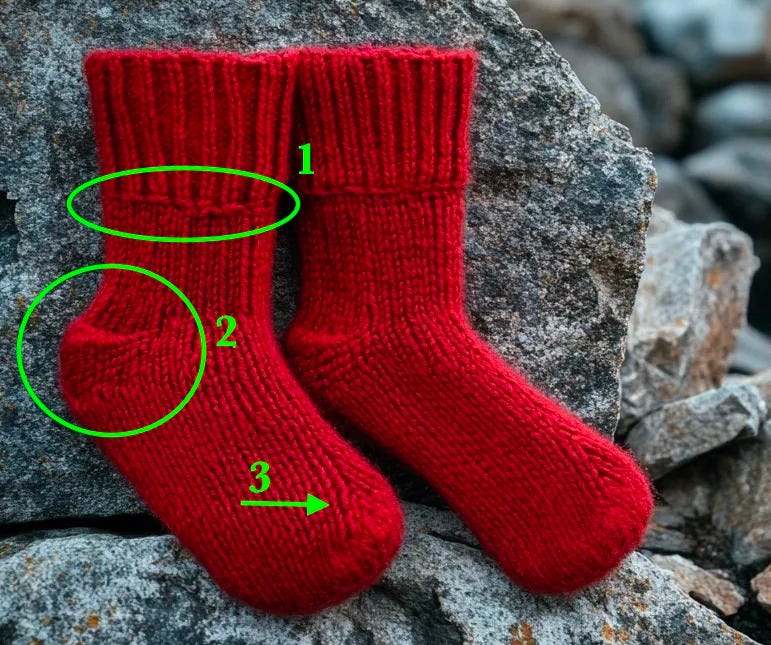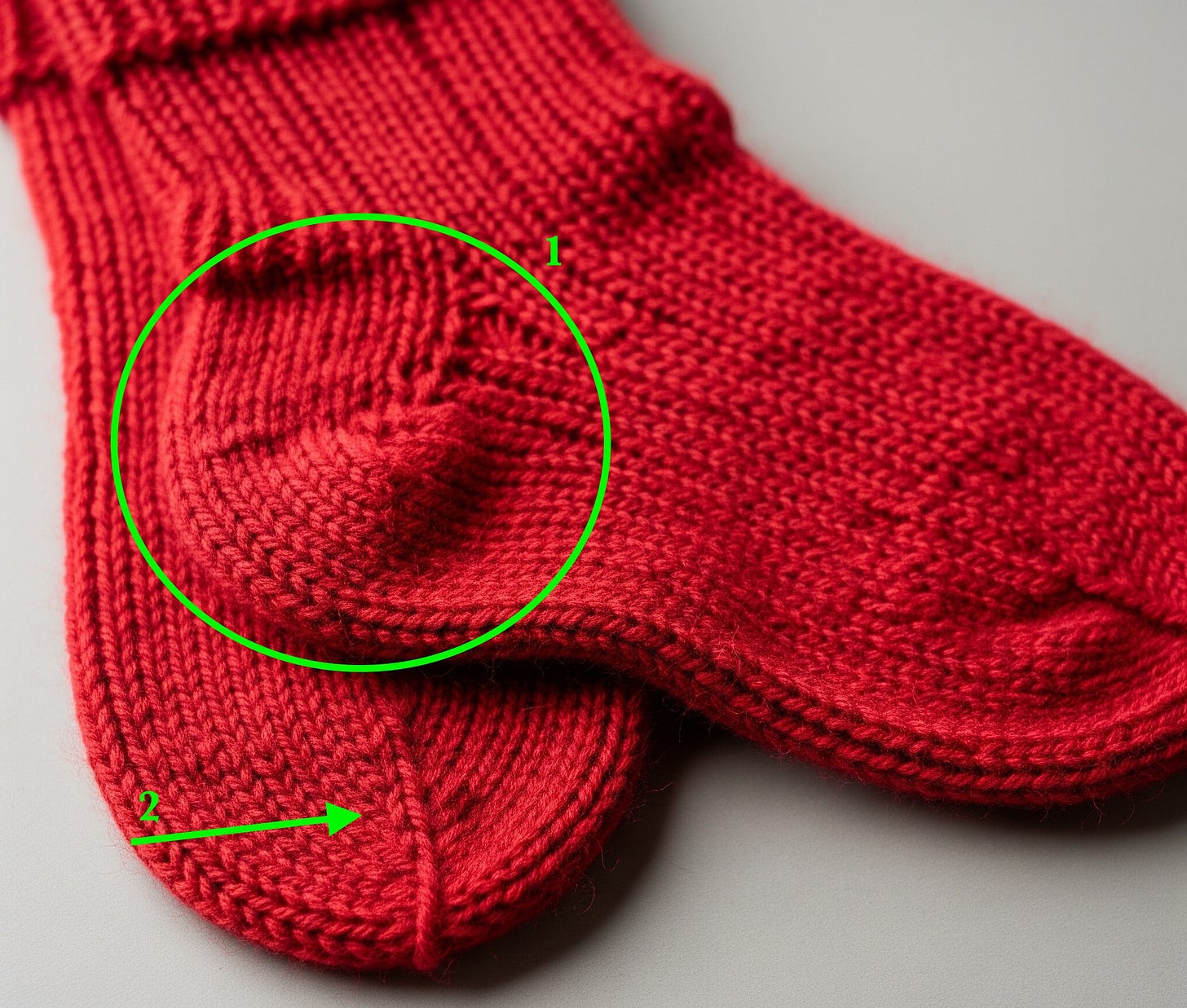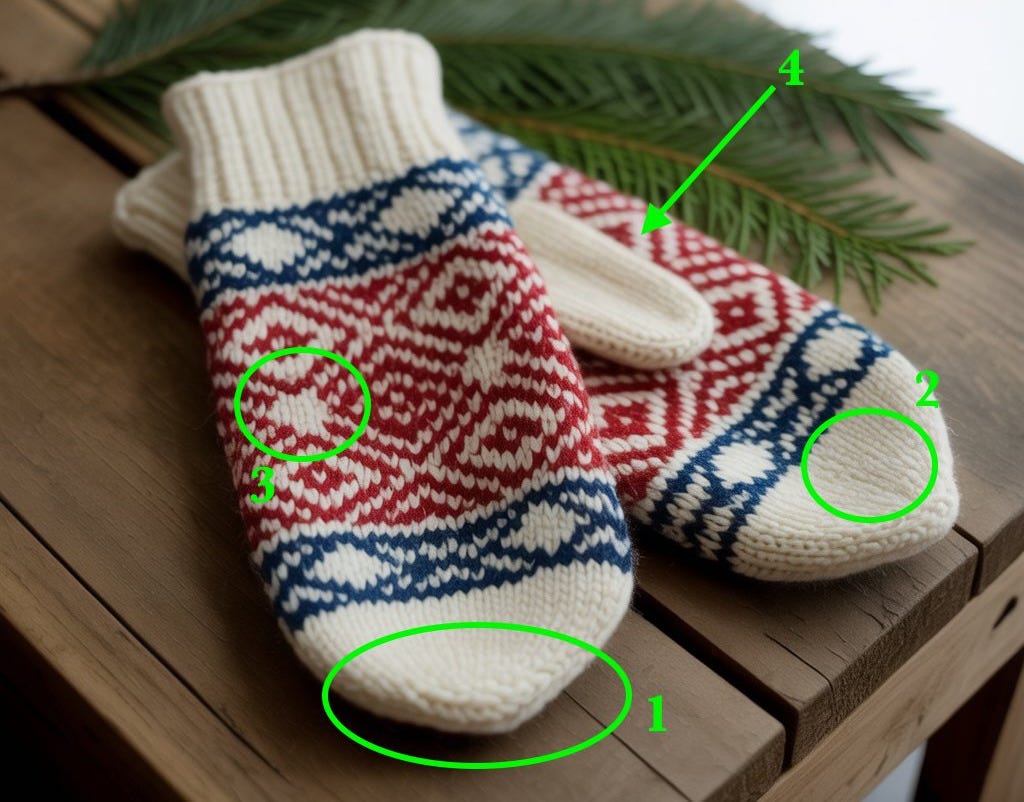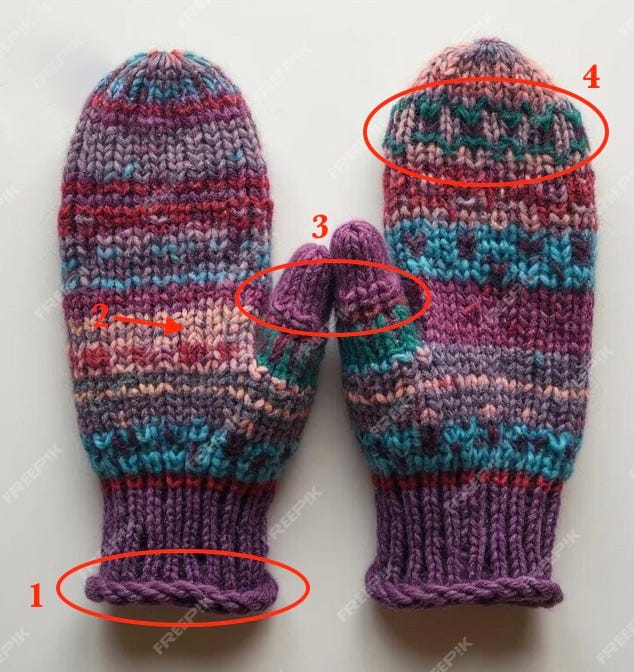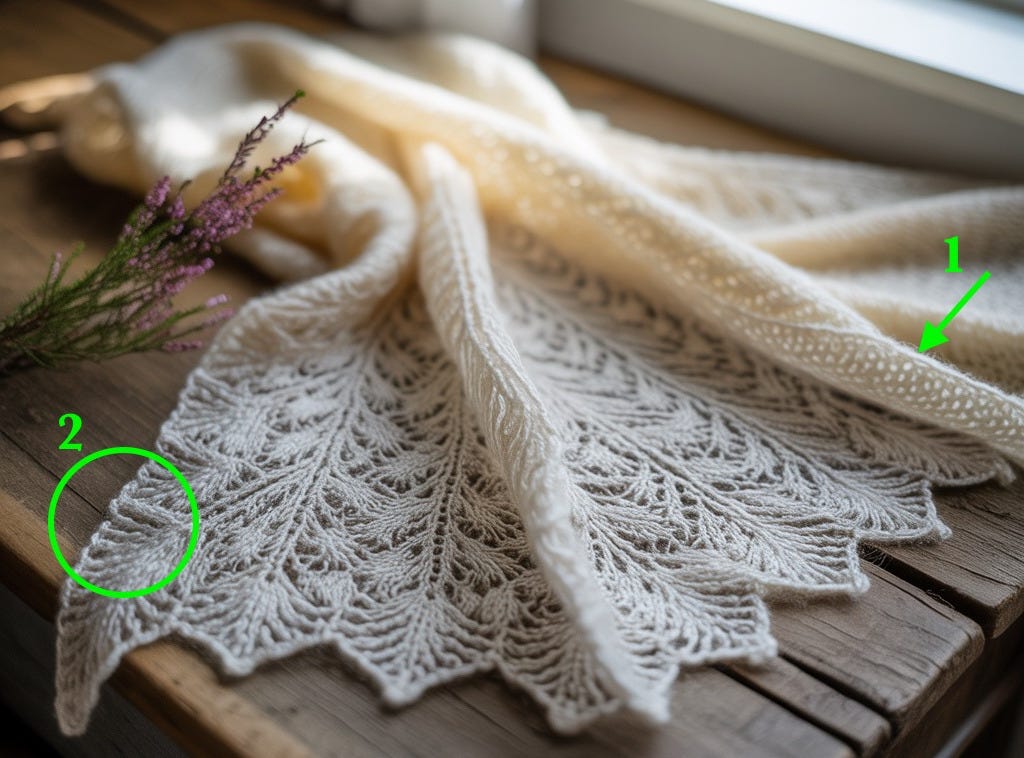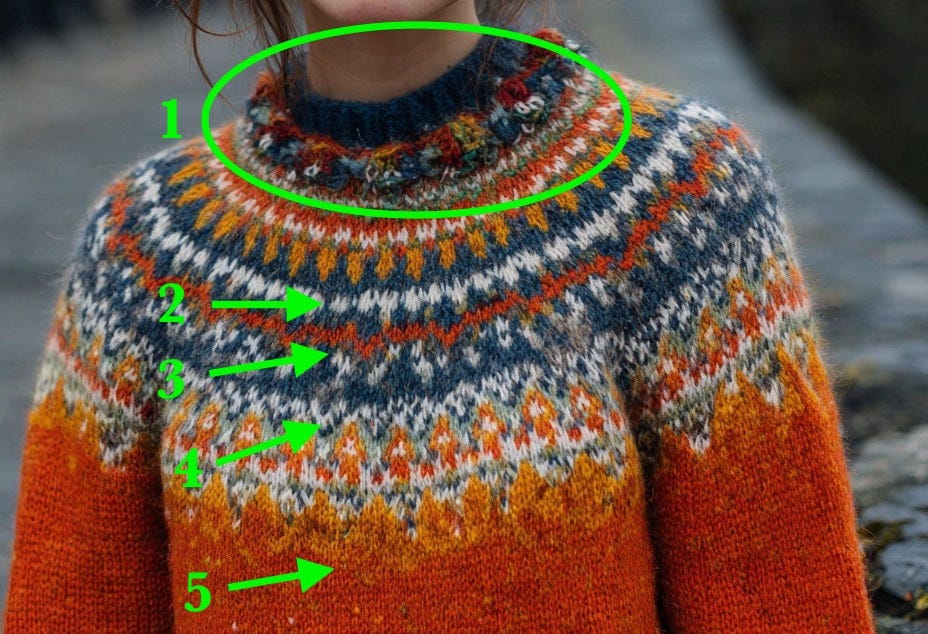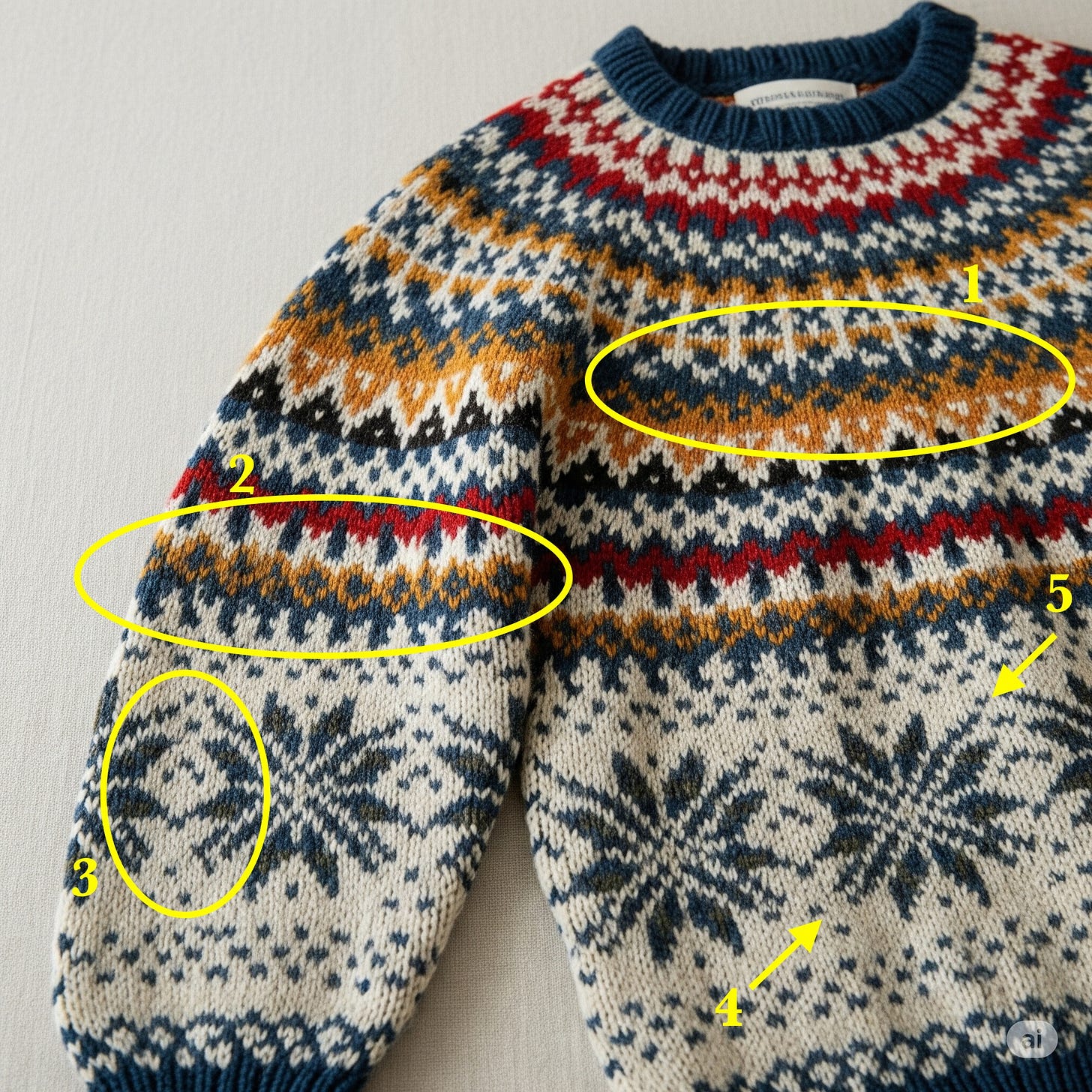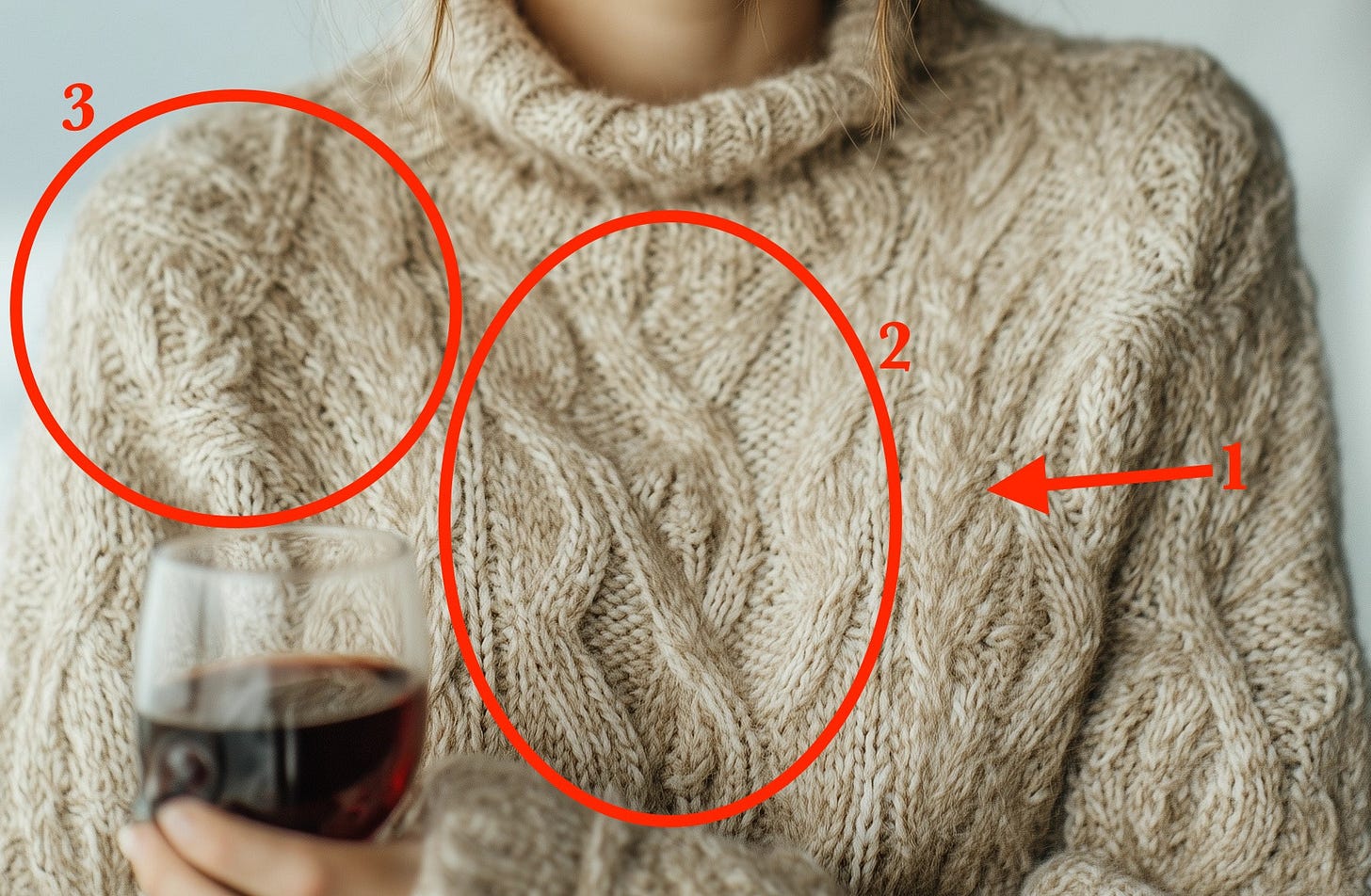Having used ChatGPT to help me write my first-ever sock pattern — and having used Midjourney to generate an execrable image to illustrate said sock — I decided to investigate the potential of other AI image generators to produce realistic knitwear.
The images in this article come from Midjourney, Freepik, Ideogram, and Gemini. Their ability to create realistic knitting varied greatly but if you know what you’re looking for, their hand in creating “socks” and “sweaters” and “mittens” isn’t hard to discern. Knowing how to knit certainly helps, as does having a suspicious mind.
Socks 1 - Midjourney
This transition from ribbing to stockinette stitch (1) might make sense if it showed a ribbed cuff folded double, so that the top edge came down over the fabric for the leg of the sock. However, the actual top edge in the photo shows that this isn’t the case. It’s hard to say what it is — but it isn’t folded down.
The heel (2) looks like a mish-mash between a short-row heel and heel flap knitted in a stitch that doesn’t exist. At first glance, one might mistake it for a blurry sort of garter stitch, but this possibility doesn’t hold up to scrutiny.
Stitch directionality on both socks, especially on the cuffs, suggests that they’re knitted toe-up. Whatever the case, the toes (3) are a graphical mess with stitch alignments that don’t make sense for either a toe-up sock or a top-down sock. The toe shape is also extremely blunt, without the gradual tapering that one should expect to see in a hand-knitted sock. It looks a bit like commercial socks that lack shaping for the toe and are seamed across the entire width of the sock.
Socks 2 - Gemini
Gemini from Google did a much better job at handknitted socks than Midjourney. Here, though, the decreases for the heel gusset and the heel turn don’t look quite right (1) although to be honest there are a lot of non-traditional ways of knitting them that might well result in something like this. (I don’t know because I knit socks with either a traditional heel flap/gusset or short rows.) Additionally, Gemini has managed to get the right idea of the toe, but the actual decreases and sts don’t line up properly (2).
Mittens 1 - Ideogram
I asked for “a pair of handknitted Norwegian mittens with Selbu patterns.” Suffice it to say that Ideogram didn’t understand the Selbu part of the prompt, but it still managed to make mittens in a vaguely Sami style, and Sami people live in Norway, so…
These mitten tips look like they’ve been knitted from the top down (1). I first learned this technique from Anna Zilboorg’s book Magnificent Mittens, and while it’s perfectly valid per se, traditional Norwegian and Sami mittens are knitted from the cuff to the tip. Nevertheless, the stitch directionality makes sense for top-down mittens. Problems arise, however, as soon as we take a closer look. Is that really knitting (2) or some other kind of fabric construction?
While the colourwork looks impressive at first glance, it’s actually got quite a few problems. The white sts between the diamonds on the blue bands seem random and misaligned. Similarly, the white spaces between the diamonds in the red bands are misshapen and inconsistent with each other (3). Meanwhile, the thumb has been placed in the center of the mitten.
Overall, I would say that the general impression is good; the details less so.
Mittens 2 - Freepik
I like the colour palette of these mittens, and just as with the Ideogram mittens I think that they make a good first impression. I also think that they were “knitted” using a self-striping yarn, which could account for the half-sts in different colours at various points.
That cabled cast-on edge (1) is amazing, but how real is it, exactly, especially given that the stitches in the rib seem to be knitted both upwards and downwards. Other tells: Not all sts line up properly (2). That weird uneven round on the thumbs (3). And that gauge issue higher up (4) that might possibly be the result of slipped sts or really bad duplicate stitch.
Shetland Lace Shawl 1 - Midjourney
This so-called shawl is a disaster. Everything is wrong with it, beginning with the material. Is it a fingering weight chainette wool yarn? Or some kind of weird synthetic or highly processed plant fibre like rayon or bamboo? The motifs are lacy, but they are not Shetland lace. Or any kind of knitted lace, really. In fact, I don’t believe that this travesty is knitted at all.
Shetland Lace Shawl 2 - Ideogram
If I didn’t know this lace scarf was AI and didn’t bother to study the picture too closely, I’d very likely head off on a wild goose chase to find the pattern. The giveaways are the lack of consistency on the edge sts (1 and 2, as well as the odd folding/draping around 1) and that weird sprig of lavender that Ideogram likes to shoehorn into its pictures of handknits.
Fair Isle Sweater 1 - Midjourney
First of all, wtf is wrong with the neckband/collar (1)?! Why does it look like a cat attacked a bunch of yarn loops that were then felted together and sewed onto a sweater?
Even if we disregard that obvious weirdness, this sweater is still clearly AI. This is particularly obvious in the yoke rings (2, 3, 4, and 5). These patterns should exhibit some kind of uniformity. Instead they are all over the place. In an impressionist painting, it might have worked but here the plain knitting on the sleeves shows the details: even tension and good stitch definition. We should therefore expect the same on the yoke. Instead we get a lot of uneven sts — the white ones for some reason are particularly bad in this regard, and look either as if they are too loosely tensioned or slipped — in addition to blurry colour motifs/bands that lack definition and clean lines.
Fair Isle Sweater 2 - Gemini
Honestly, this looks great. Right? Right? Except when you start looking, you see that it’s either an AI pic or a sweater knitted someone who overestimated their ability to watch TV and follow a chart at the same time. There’s a lack of consistency in the pattern — those dark crosses sometimes have a gold centre st and sometimes not (1), and the dark patterning under the gold diamonds on the sleeves (2) and body looks random. The stars are fancy, but they lack symmetry in the voids (3) and along the cross arms that split the motif into quarters (4 and 5).
If you were inclined to give the benefit of the doubt to an intoxicated knitter, look closely at the collar. You’ll see that the k2 from the k2p2 rib is actually k1.5, a physical impossibility.
Cabled/Aran Sweater 1 - Midjourney
I will give AI this: it understands that Aran sweaters feature a main panel in the middle that’s flanked by smaller side panels. So if you ask it AI to generate a picture of an Aran sweater, it will usually get the theory right. The problem is the cables themselves. In this picture, we see a braid (1) grow out of something that was previously a diamond. Then the braid itself dissolves into nonsense higher up at the shoulder.
Meanwhile, the central panel (2) contains strands that tangle and cross in nonsensical ways. The main motif isn’t clearly defined, and strands from the central diamond run into the side cables. Strictly speaking, this is possible — but in a real sweater it would be consistent and symmetrical.
Lastly, the sleeve (3) flows into the shoulder in a way that isn’t physically possible. If you look closely, you can see one of the cable strands from the body turn and dissolve into the sleeve. Wow!
Cabled/Aran Sweater 2 - Freepik
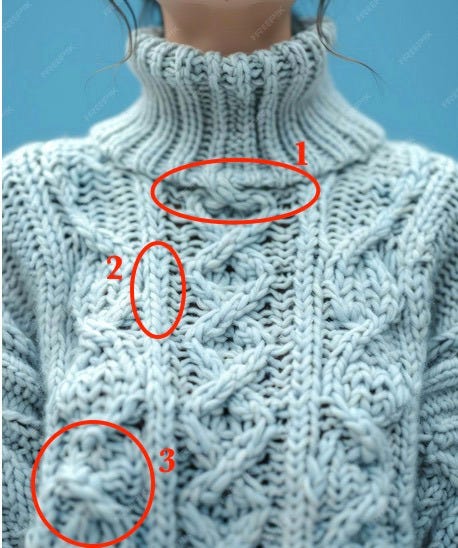
Rong rong rongity rong. The cable mysteriously flows into the turtleneck collar (1). More problems with columns that are 1.5 sts wide (2). Who knows what kind of mess is happening in the side cable (3). And so much more that I just can’t bear to describe.
Stuffy 1 - Midjourney
AI stuffies are apparently very popular. They also look quite realistic. I will admit that I’d probably be taken in by a lot of the stuffy pictures that I found on Midjourney, Freepik, and Ideogram. A big problem for me in this regard is that I don’t knit stuffies. So I’m not very familiar with how they’re shaped and sewn together.
Still, the rabbit in this picture has some suspicious features. The crown of its head doesn’t appear to have any decreases (1). Now, it is possible that these decreases could have been done higher up, but then I would expect the fabric to bunch around the area indicated by he arrow. Instead it’s very smooth and even.
The colour shifts also give away the photo’s AI origins. The rosy cheeks (2) are particularly egregious; in real life, they would probably have been done using intarsia or duplicate stitch, but here the pink colour looks to have been painted on. Several sts are only half pink. The same issue pops up again on the arm/sleeve (3) and on the pants (5).
Stitch columns are unclearly delineated, both on the torso (4) and on the arm (3). These issues cannot be attributed to increases or decreases; these sts simply don’t line up properly in the image. This problem is also visible on the foot (6), and both feet lack a depth/connection with the rest of the rabbit as they seem to be hovering in front of the body.
The problem with these problems, as it were, is that they’re quite detailed. Would I see them at a glance on a thumbnail on my phone? Probably not.
Stuffy 2 - Gemini
This image shows some characteristic limitations of AI: it knows what a rabbit is, it knows what a stuffy is, and it knows what knitting is. So it produces a rabbit stuffy with knitted texture, but struggles to make it truly realistic due to its lack of understanding of knitting techniques.
The construction of this rabbit is actually quite interesting to me, especially how the back body seems to be picked up from the front body and knitted in the opposite direction. But there are decreases/increases missing from the head and feet that suggest it probably isn’t a real pattern.
The ears are very fuzzy, and I’m betting that it’s because Gemini made the association between rabbits, knitting, and angora yarn, the latter of which tends to have a big floofy halo when knitted up.
Final Thoughts
Go outside and touch grass.



